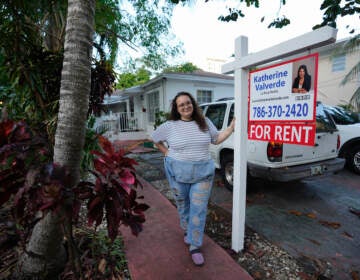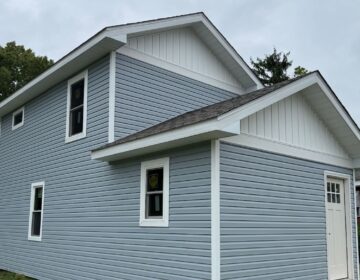Pennsylvania needs rental assistance and eviction diversion programs, activists and lawmakers say
Study cites housing affordability exacerbated by COVID-19 pandemic.

Patty Torres, organizing director for Latino advocacy group Make The Road PA, speaks at the capital. She's accompanied by member leaders of Make The Road, State Sen. Nikil Saval, and State Representatives Sara Innamorato and Elizabeth Fiedler. (Armando Jiminez-Carbarin / Make the Road Pennsylvania)
Several state lawmakers, researchers and activists gathered in the state capital to call for an inclusive, permanent fund to help renters in the commonwealth.
The action last week was fueled by a new study by the left-of-center Keystone Research Center and PA Budget and Policy Center that looks at housing affordability before the start of the COVID-19 pandemic and currently.
Kehinde Akande is a policy fellow at the PA Budget and Policy Center and an author of the report.
“The two main takeaways are that eviction mitigation is working to keep people in their homes and it should be expanded,” Akande said. “And a permanent rental assistance fund is needed in the state for the large numbers of cost-burdened families in Pennsylvania.”
The study argues that there was a housing affordability problem before the COVID-19 pandemic and that the global health crisis exacerbated the issue for the lowest income households and for Black renters.
Some of the challenges were brought on because employment of low wage workers fell 40 percent due to the shutdowns in the leisure and hospitality industries. Another challenge is that many tenants are seniors, many of whom live on fixed incomes; people ages 65 and older make up nearly a quarter of renters.
Before the pandemic, more than quarter of renter households were extremely low income. Of those homes, more that two-thirds spent half of their income on housing. The cost of living has increased faster than wages of many renters.
COVID-19 worsened the rental environment because it jeopardized low-income jobs and disproportionately hospitalized Black people and Latinos. The amount of rent owed per renter households in arrears steadily increased over the pandemic to more than $3,000, and sat at $2,800 at the beginning of this year.
The number of households in arrears spiked to more than 336,211 in late 2020.
Conversely, the study also pointed to programs that it deemed as successful in protecting renters. The PA Supreme Court Eviction moratorium in March 2020 dropped eviction filings down from around 2,000 filings to nearly none.
That moratorium was superseded by the CARES Act eviction moratorium. When the federal moratorium ended in July 2020, eviction filings spiked to nearly 3,000 cases but dropped by two-thirds due to the CDC moratorium extension.
The paper also notes that Philadelphia’s Eviction Diversion Program, adopted in September 2020, helped renters and landlords access assistance. An aspect of the program makes landlords enroll in the diversion program and apply for rent assistance before filing an eviction for nonpayment.
Also in Philadelphia, data collected from eviction filings found that 96 percent of tenants who had legal representation avoided an involuntary move or evictions.
The study also details experiences of renters in the commonwealth who were unable to access help or were even taken advantage of by their landlords.
The paper gives policy suggestions to ease the burden for renters.
Possible short-term solutions include eviction diversion programs in county courts, focusing more on helping renters apply for assistance, expanding eligibility regardless of immigration status and allocating unused American Rescue Plan Act funds to hardest hit counties.
Long-term policy solutions include a state-funded “right to counsel” program for renters at risk for eviction, crafting legislation to end evictions without “good cause,” funding a long-term emergency rental assistance program and providing funds for developing more affordable housing.
Ty Redden is an assistant professor of Africana Studies at Gettysburg College, who specializes in housing, social policy, and urban governance failures. She was not involved in the study.
After reviewing it, she said it appeared to be sound and accurate.
“I was not surprised by the results of the study; it’s fairly typical across the country,” Redden said. “This is not a Pennsylvania problem, this is a United States problem, and the pandemic is just squeezing people who are already being squeezed too tight by our existing economic disparities.”
Redden noted the study highlights the precarious situations of hundreds of thousands of renters.
“We’re talking almost a third of Pennsylvania renters are making less than 20 grand a year,” Redden said. “It’s more than concerning, it’s terrifying.”
Terry Lerch, a landlord of several residential properties in Lebanon County, said he feels that the process tenants had to go through to receive COVID-19 rental assistance money was too lengthy and not user friendly.
But Lerch said he strongly disagrees with the study’s policy suggestion of providing a universal right to legal counsel to tenants (and not also landlords). He also takes issue with sealing eviction records of tenants.
“If someone is not paying rent, then landlords aren’t getting income, they should get a lawyer too,” Lerch said. “Sealing (eviction) records is totally wrong when I can get a credit score to see if someone has a bad credit history.”
Alan Shuman, a real estate developer who owns both commercial and residential properties in Reading, said he disagreed with the premise that emergency rental assistance should be available to everyone – including undocumented immigrants.
“I don’t think taxpayer dollars should go to people who are here (without documentation),” Shuman said.
Shuman also said dedicating government funds for low income housing means subpar developments. He said tax credits for middle-class housing developers would overall benefit an area more.
Both Shuman and Lerch said they feel the pressures of the pandemic have passed for most of their residents.
Democratic State Sen. Nikil Saval, of Philadelphia, was among the crowd that gathered at the capital to call for more assistance.
He said that lessons can be taken from when resources were available during the pandemic.
“As the pandemic swept across our country and our systems began to buckle under the enormity of the need, eviction diversion and rental assistance were lights guiding us toward a world in which government was operating as it should: creating a safety net capable of catching our people when we needed it the most,” he said.
WHYY is your source for fact-based, in-depth journalism and information. As a nonprofit organization, we rely on financial support from readers like you. Please give today.






